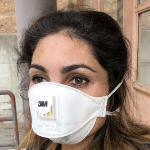
Now that we’ve gotten settled in, and the febrile rate is down 20% from Kinsa’s trendline (at least it is here in Sonoma County, CA), it’s time to start thinking about what’s next.
Months, probably years, of carrying on like this, that’s what’s next.
This virus is:
- not directly treatable, though we can treat the symptoms
- not addressed by any existing vaccines
- not going away
All three of those are important, because that tells us that we have to keep on like this until we have either a treatment or a vaccine.
It’ll probably be a vaccine.
Treatments for viruses are hard, really hard, to come up with.
It’s been over 30 years, and we’ve only recently gotten decent treatments for the HIV virus.
So don’t expect an antiviral treatment to come along any time in the near future.
The best treatment we’ve got, and will probably have for years, is trying to manage the symptoms long enough for the immune system to manage the virus for itself.
That is not helpful.
We are pretty accusotomed to making vaccines for some viruses, though; we make a new one for influenza every year after all.
This one is new, but it’s still a virus and we have research institutions and expertise already set up for that kind of thing.
So, we have to keep this up until we get a vaccine.
Here’s where we get to the bit that none of the politicians or journalists seem willing to say:
That’ll almost certainly be at least 2 years.
Yes, years.
(I’m currently homeschooling my elementary school-aged kids; believe me: this doesn’t excite me either.)
But, sadly, the world doesn’t run on what excites me; sadly, indeed.
So now that we’re settled in, it’s time to start adjusting how this society works in order to make it for 2 years of:
- no unnecessary physical contact
- minimal usage of shared spaces
- delays in moving material around
- limited travel, even short-range
Because that is what it will take to keep the level on concurrently-infected down low enough for our health care systems to treat all of the 20-25% of cases that need medical support to pull through.
We can do this.
Because we have to.
(Other posts on this topic are here.)


3 thoughts on “Social Distancing: It’s Not Just Hunkering Down Anymore”